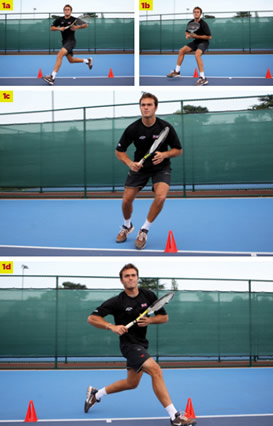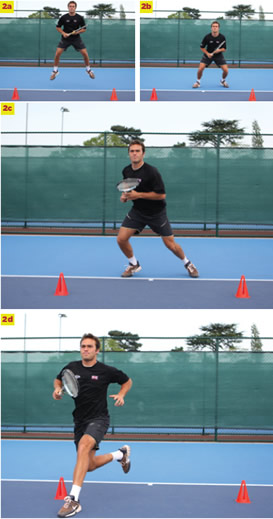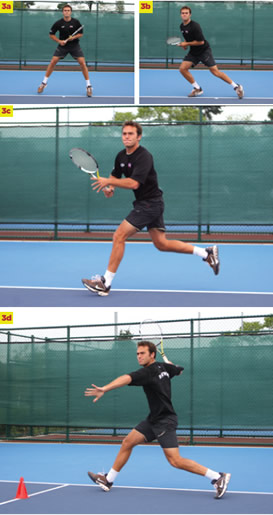
First Step Drills
World-leading fitness trainer Jez Green outlines five simple court drills designed to get you off the spot and to the ball at breakneck speed
When it comes to tennis movement, it is the first step that is by far the most crucial. This point was covered in detail in the March 2008 issue of ACE. This month I am going to take you through some simple yet effective drills designed to train the first step. The end result should be quicker, more powerful and efficient movement to the ball.
Before I do, however, let me remind you of some of the most important technical points regarding the first step:
- Split step: Before taking your first step you need to ‘split step’, but it’s important to note that the two movements i.e. doing a split step and taking your first step are intrinsically linked and are in effect one movement.
- Split-step timing: The split step is a ‘jump move’ or ‘jump step’ of enormous importance. The key to an effective split step is to be landing when your opponent makes contact with the ball. The best time to start your jump is as your opponent starts to initiate their forwards swing.
- Types of split step: There are different kinds of split step for different parts of the court. The ‘sit split’ is when both feet land at exactly the same time, and is commonly used on the second volley close to the net or on the return of serve. The ‘first volley split’ or ‘adjusting step’ is used as you’re moving forwards to hit your first volley and involves landing one foot in front of the other. The ‘baseline split’ or ‘split and glide’ is, as the name suggests, performed on or around the baseline, the movement being similar to that of a speed skater when pushing off. At an elite level, the split is uneven, i.e. you land one foot before the other. This enables you to open the opposite hip to help you move off.
 Shin angle: It’s important to create a positive shin angle of 45° in relation to the ground so that you can push off explosively.
Shin angle: It’s important to create a positive shin angle of 45° in relation to the ground so that you can push off explosively.
- Weight transference and lean: To move explosively you need to drive downwards from under your centre of gravity, i.e. your belly button, and lean your upper body in the direction of the ball.
The drills described below have been performed by all the players I’ve ever worked with, including Andy Murray, Daniela Hantuchova, Tatiana Golovin and Kristina Brandi. They need to be performed with perfect balance and posture in an ‘athletic position’ with a low centre of gravity and a wide base at all times. To get this position right, it helps to imagine you are moving under a low ceiling!
1. Figure-of-Eight Lateral Drill
Aim: This drill trains the explosive first step, speed and coordination required when running to wide balls. It also emphasises the use of adjustment steps around the ball.
Method: Place two cones five foot-spaces apart either side of the centre mark on the baseline. Start with your right foot directly behind one of the cones (right foot for a right-handed player – vice versa for a leftie). Move in a figure of eight around the two cones, staying as close to them as you can without hitting them. Drive off with a big first step whenever you change direction during the drill (pics 1a-1d).
Repetitions: Perform as many figures of eight as you can in 30 seconds. Repeat three times, with a minute’s rest in between. Fit players should be aiming for 12 figures of eight in 30 seconds.
 2. First Step Forwards
2. First Step Forwards
Aim: This drill trains the explosive first step forward to track down a drop shot. It emphasises the split step followed by the dynamic first move.
Method: Place two cones five foot-spaces apart either side of the centre mark and a metre or so in front of the baseline. Starting on the centre mark, use a dynamic split step (with an even landing – both feet at the same time) then drive into the first step forwards around one of the cones. If you are going to the left cone your right foot goes first; if moving to the right cone, move your left foot first. Facing forwards, back-pedal to the centre mark using as many dynamic little steps as you can (pics 2a-2d).
Repetitions: Move as many times around the two cones as you can in 30 seconds. Repeat three times, with a minute’s rest in between.
3. Forehand and Backhand Repeats
Aim: This drill works on movement to both the forehand and the backhand sides.
Method: Place a cone on the inside tramline on the forehand side. Start with a ‘baseline’ split, whereby you land more on your left foot (for a right-hander; pic 3a) so that you can open your right hip to make the first step (pic 3b) and move to the cone using just two big steps (pics 3c & 3d).
 Simulate a forehand stroke and then return to the middle using smaller, choppier yet dynamic sidesteps. For the backhand, move the cone over to the other side of the court, ensuring that when you split you land more on your right foot, thus enabling you to open your left hip ready for the all-important first step. Simulate the backhand stroke and return to the middle.
Simulate a forehand stroke and then return to the middle using smaller, choppier yet dynamic sidesteps. For the backhand, move the cone over to the other side of the court, ensuring that when you split you land more on your right foot, thus enabling you to open your left hip ready for the all-important first step. Simulate the backhand stroke and return to the middle.
Repetitions: Continue for30 seconds. Repeat three times on each side, with a minute’s rest in between.
Images courtesy of ACE Magazine
For mor Physical Conditioning Articles go to www.jezgreen.com

